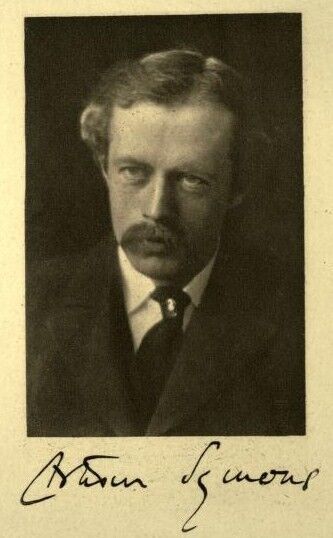The Early Life of Arthur Symons
Arthur William Symons (Feb. 28, 1865 — Jan. 22, 1945) was a poet and critic born at Milford Haven, Pembrokeshire, England. He is a frontrunner of the Decadence crusade in the literary world and was the first English advocate of Symbolism that had originated in France.
Symons was largely schooled privately, spending most of his time in France and Italy. At 16, he moved to London, where he found a niche in its vibrant literary community. Determined to be a writer, he was a part of the Rhymer’s Club, consisting of poets like W.B. Yeats, Ernest Dowson etc.

The Symbolist and Decadent Movement
Symbolism was a literary movement that was opposed to the rigid conventions governing theme and technique of poetry and instead vied to communicate the ineffable sensory experience of an individual through art.
Symons’ seminal work “The Symbolist Movement in Literature” (1899), an expansion of his acclaimed essay “The Decadent Movement in Literature”(Harper’s, November 1893), introduced his readers to the Symbolist movement which Symons’ described as ” an attempt to spiritualise literature.”
Symons, at one time, regarded both Symbolism and Impressionism as subsets of the parent category of Decadence and considered them to be rebellions against realism. He defined this common, decadent thread as, “an intense self-consciousness, a restless curiosity in research, an over-subtilizing refinement upon refinement, a spiritual and moral perversity.”
In England, the decadents were 1890s literary figures such as Arthur Symons (“the blond angel”), Oscar Wilde, Ernest Dowson and Lionel Johnson, who were members of the Rhymers’ Club or contributors to The Yellow Book.
Despite a shared ideological descent from Baudelaire and being associated as parts of the same sphere of anti-establishment literature, both these movements soon came to be distinguished from one another.
Arthur Symons’ works
Symons’ notable works strongly resonated with the fin-de-siècle feeling or “end-of-the-century gloom”. His poems are teeming with elements of decadence present in late Victorian literature.
He published three volumes of poetry. The first one, “Days and Nights” (1889), contained a series of dramatic monologues. This was followed by “Silhouettes” in 1892 and “London Nights” in 1895. These were described as containing “admirable impressionist lyrics, sensitive to the complex moods of urban life.” He wrote a preface to the second edition of “Silhouettes” in praise of the artificially charming.
The imagery in his poems, like decadent literature, does not draw itself from nature. His poems find itself set in music halls, the London bars, streets, rooms of prostitutes etc. Moral indifference and an attraction to the perverse and sordid framed his literature. His poems are characterised by expressions of sexual indulgence.
” W.B. Yeats thought that La Mélinite: Moulin Rouge was “one of the most perfect lyrics of our time.” This poem pays homage to Jane Avril, a celebrated dancer from when Symons a frequently visited the Moulin Rouge in Paris.
Maquillage
Critics were quick to gush over the poems contained within these books. For example, “Maquillage” that employs artifice as its substance, was described as being “one of the best statements of the aesthetic cult of artifice.
The title of this poem originates from the French word “macquiller” which translates to “make up”. Symons had brilliantly reproduced yet another poetry having a fin-de-siecle feel by taking inspiration not from elements of nature but the complex emotions forming our transient selves, the artificial. He talks maquillage being the carrier of beauty and not just accentuating it.
His work is “impressionist” and draws visuals of carnal experiences, the metropolis becomes a subject of his decadent imagination.
Silhouettes and London Nights
Symonsian poetry is a nexus between the corporeal sense experience and the metropolitan background that it occupies. His visualisation of London draws itself from the nooks and crevices of the metropolitan and his poetry is a fugitive in those corners of the town.
Both these poems are attempts to textualise his fleeting carnal encounters. The Symonsian woman is artwork blending delicately into the artificial settings of his poem,
Death
In the years 1908-1910, Symons fell prey to a grave set of mental illnesses curtailing his literary career. In one of his last pieces of writing, “Confessions: A Study in Pathology” (1930), he movingly recounted his earlier mental breakdown. Symons died on Jan. 22,1945 in Kent, England.